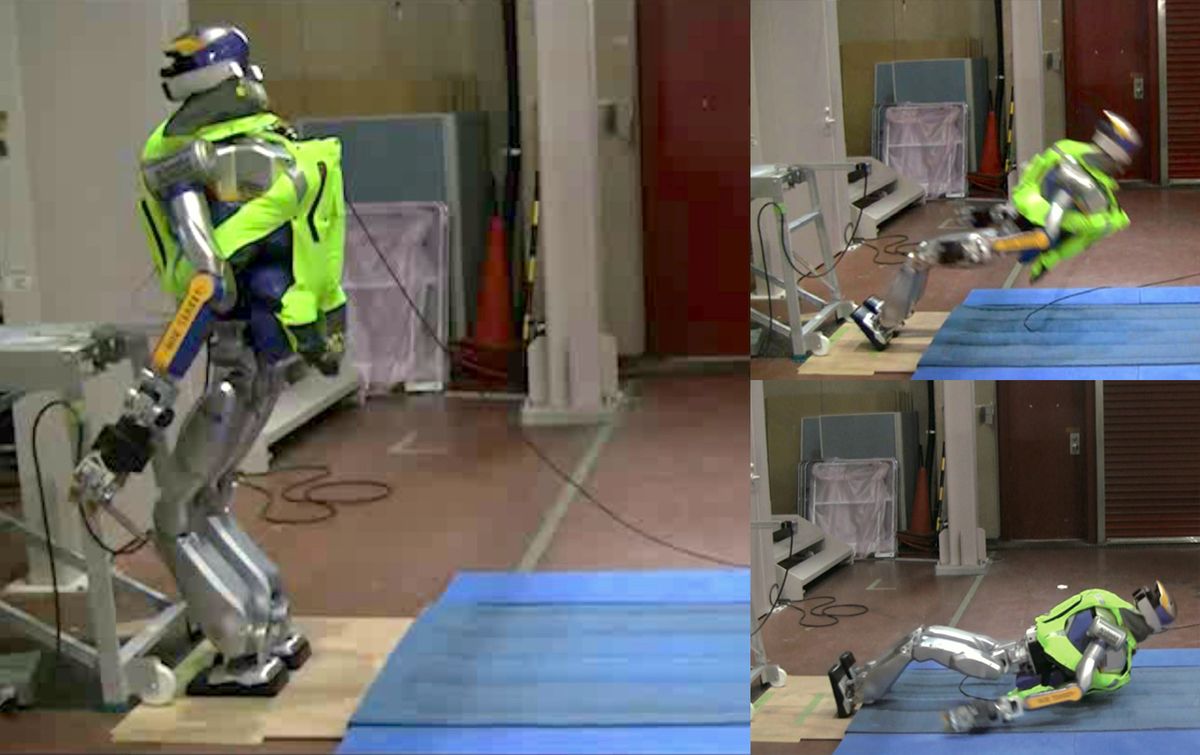Humanoid robots are generally designed with the expectation that they won’t fall over. And most humanoid robots do, in fact, spend most of their time not falling over, although this is frequently because their creators don’t trust them enough to let them do anything fancy without being tethered to some sort of safety system. You can build your robot to be extradurable and consequently make falling over less destructive than it would be otherwise, but then you end up overengineering your hardware by designing it to be able to handle something that (ideally) won’t happen often, if ever.
The ideal emergency safety system for humanoid robots would be cheap, reliable, lightweight, easy to integrate, and able to deploy at very short notice during the small window of time between when a robot detects that it’s falling and when it hits the floor. And we have safety systems like that already: airbags.
Fall-damage mitigation for robots (and for humans) is primarily about spreading out the force of impact over as much time and area as possible. There are different ways of doing this—one is to use limbs to try to turn an in-progress fall from a pure face-plant to a more gradual multipoint of contact collision, with the arms absorbing some of the energy. A slightly more complicated strategy is to turn a fall into more of a roll, using hips and shoulders. The objective is the same: minimizing the amount of force that one area of the robot experiences at one time.
For a humanoid like HRP-2Kai, which is 1.71 meters tall and weighs 65 kilograms, a face-first fall onto a sport mat can results in accelerations of well over 100 g. Researchers at AIST in Tokyo conducted a series of experiments (using a stunt-double robot) and found that peak accelerations during fall tests ranged from 82 g to 113 g, and the robot would bounce after falling, experiencing a second impact of up to 40 g. This can break things. Badly. Even equipped with knee and hip padding, the robot still experience accelerations of around 60 g, which is much better but still destructive.
To improve on the shock-absorbing qualities of padding, the AIST researchers have been experimenting with airbags instead. These airbags are somewhat similar to airbags in cars, albeit a little less violent—since robots don’t fall as fast as cars crash, the explosive inflation of an automotive airbag can be replaced by the slower and gentler (but still quite brisk) inflation driven by compressed gas from a small cylinder of CO2. Initially, they experimented with personal airbag protection systems designed for “equestrian or motorcycle riding” that you can buy on Amazon for US $500. That’s way better than having to design one from scratch. Triggered by an accelerometer, these airbag vests fully deployed in about 0.2 seconds, and reduced the impact of the dummy robot on the ground to a mere 23 g. The researchers were comfortable enough to try protecting HRP-2Kai itself from a fall with this airbag system:
After this experiment, the control computer of HRP-2Kai had hanged up and we obtained no log of robot itself. We found the interface board loosened from the PCI bus connector, and recovered the robot system after plugging the board in again. Also it was found that the neck pitch link had deformed. The mechanical weakness of this link have been a problem during our preparation of DRC finals, and we need reconsideration of its design. Despite of these two problems, other parts of HRP-2Kai’s hardware were intact. Two weeks after this experiment, we had an open house, where the robot successfully performed tasks of valve opening, walk on irregular terrain, and door opening. Therefore, we can conclude that the fall down experiment did not severely harm the HRP-2Kai.
This is pretty good, considering that the airbag was not explicitly designed to work with the robot, and the robot was not explicitly designed to work with the airbag, either. A little bit of optimization on either side might have mitigated the neck problem, for example. The first paper on this research was published in 2016, but we saw an update during the workshop on Humanoid Robot Falling at IROS. Sadly, we don’t have permission to share any of the videos, but lead researcher Shuuji Kajita at AIST told us that they’re working on an airbag system for HRP-5P that they should have ready for ICRA in May.
Evan Ackerman is a senior editor at IEEE Spectrum. Since 2007, he has written over 6,000 articles on robotics and technology. He has a degree in Martian geology and is excellent at playing bagpipes.



